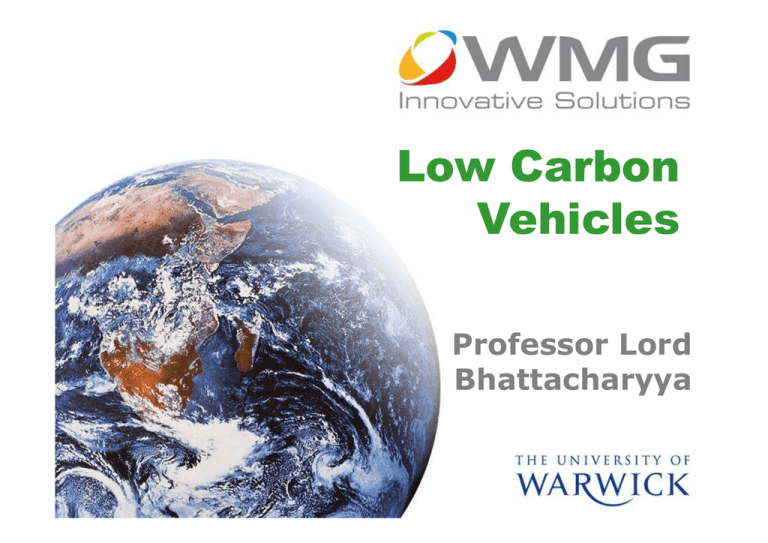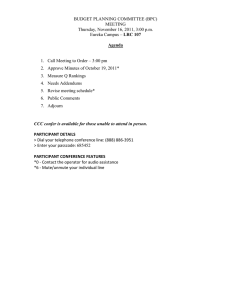Low Carbon Vehicles Professor Lord Bhattacharyya
advertisement

Low Carbon Vehicles Professor Lord Bhattacharyya About WMG • Established in 1980 • Over 280 staff in 4 main buildings • £32m annual income, – less than 10% from government • Effective relationships with over 500 companies • Our aim is to create maximum impact for our partners: – research, knowledge transfer and education – university/industry partnership – value adding innovation Pressure for Low Carbon • Scientific evidence • Resource pressure • • Need for energy supplies • Demand for Travel • Consumption Political/regulatory pressure Climate record and projection: Source: EPA But what about the needs of consumers? The Low carbon challenge in automotive sector Regulatory challenge • EU car fleet target:130 grams of CO2 per kilometre by 2015, – – likely 95 grams in 2020. USA requires 250 grams of CO2 per mile by 2016 (avg) – Social challenge • Consumer demand increasing – • • • India, China, Malaysia. Should not seek to control or limit desire to travel. Hypocritical stance in west? Technological challenge • – manage these demands and meet consumer needs Carbon Challenge: meeting consumer need Electric vehicles? • – 20+ new vehicles being planned but.. – Old problems remain • battery technology – weight • the need for infrastructure • Consumer experience: – Range anxiety – Speed limits – Overnight charging Edison’s EV… …and Porsche’s Hybrid Range Issue still major diesel petrol hydrogen battery small car Weight family car large saloon full SUV 0 200 400 600 800 Range (km) 1000 1200 1400 Source: JLR What do we need to succeed? R&D increase • – – Government & Private Many pathways to focus on Collaboration • – – – between firms through supply chain industry/academic Focus on CO2 reduction • – – Don’t attachment to particular technology. Focus on Consumer experience Jaguar C-X75 Concept car Wide range of routes Source: NIAGT Specifics: Propulsion Different solutions.. • Hybrids • Plug Ins/REEV • Fuel Cells – “ten years away for last fifteen years” Assessment- • – Dynamometer – Battery cycler – WARPSTAR : WARwick Powertrain Simulation Tool for ARchitectures • Predicts fuel economy / CO2 • Library of real-world components WMG VEF Dynamometer REEV Thermal Modelling Specifics: Waste energy recovery – Research ways to recover, utilise waste energy of future Electric and REEV (rangeextended EV) powertrains – Identify appropriate and alternative energy storage routes to complement battery technology REEVs in development (source: Ecogeek) Specifics: Materials Light-weighting Sustainable materials • • – Worldfirst F3 made from sustainables/renewables New Processes • – Paint Shops WMG Worldfirst sustainable F3 Car Specifics: Consumer behaviour –a person in a hurry ! 110 160 100 150 90 140 80 130 70 120 60 110 50 100 40 90 0 1 2 3 4 5 6 7 8 Distance (miles) Participant 1 Participant 2 Participant 3 Participant 4 Participant 5 Participant 7 Participant 8 Participant 9 Participant 10 Altitude (m) Participant 6 Driving style impacts current emissions – and future expectations e.g. Cruising up hills - constant speed, constant throttle… e.g. Acceleration from 30mph to 60mph impacts consumer reaction to vehicles. 9 A lt it u d e (m ) Participant Comparison (Vehicle Speed, M6 Section) V e h icle sp e e d (m p h ) Depends on performance of the car. But also: •Driving experience •Personality •Circumstantial Specifics: Consumer behaviour Effect of Driving Style on Economy • – New Low carbon vehicle models must be validated • – How do drivers react to new technologies? Understanding of driver behaviour must lead to robust control strategies • – – • Recent EV trial data has shown 87% difference between best and worst drivers on a city circuit If people want “roar”, how can we provide in no-IC environment? How do we encourage “low carbon” driving styles? Impact on CO2 and local emissions should be understood Specifics: Sound Engineering: ELVIN He can be given any sound character • – conventional vehicle, – UFO, – white noise, – new proposal, etc........ • Sound he emits dependent upon his speed and state • Also can evaluate sounds in laboratory conditions Conclusions • Invest in all the research routes we can – Solutions and barriers will crop up in surprising places • Put consumer needs first – They will decide if tech is successful • Partnership essential – none can do alone. • Understand different markets – Urban/Rural, small vehicle/large, Don’t dictate how we get there. Explore all paths to destination.



